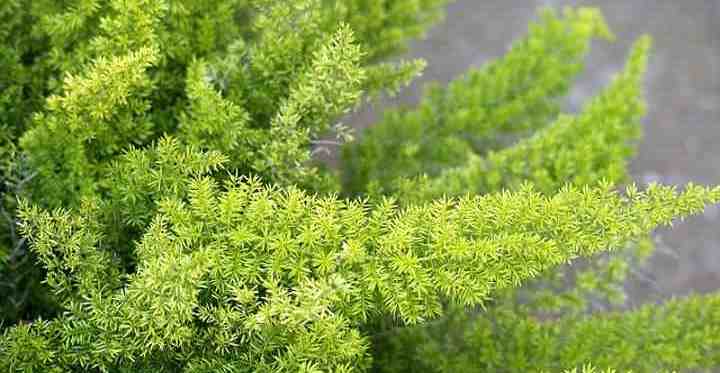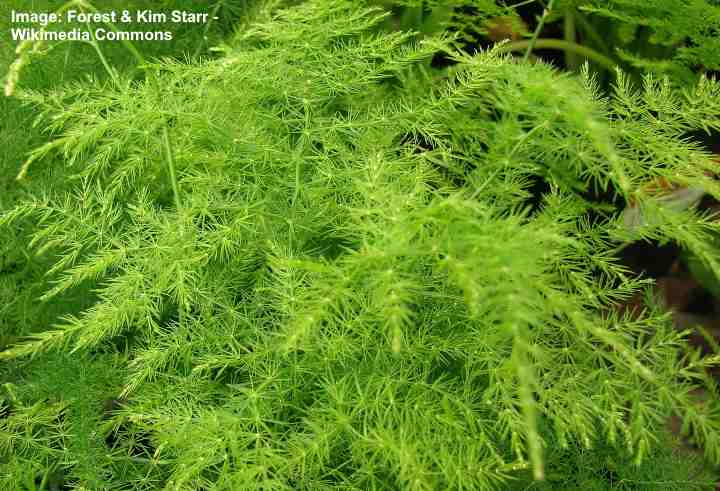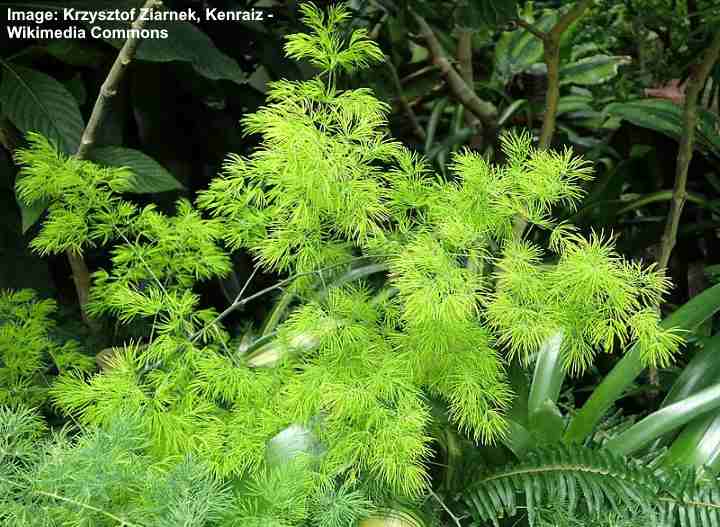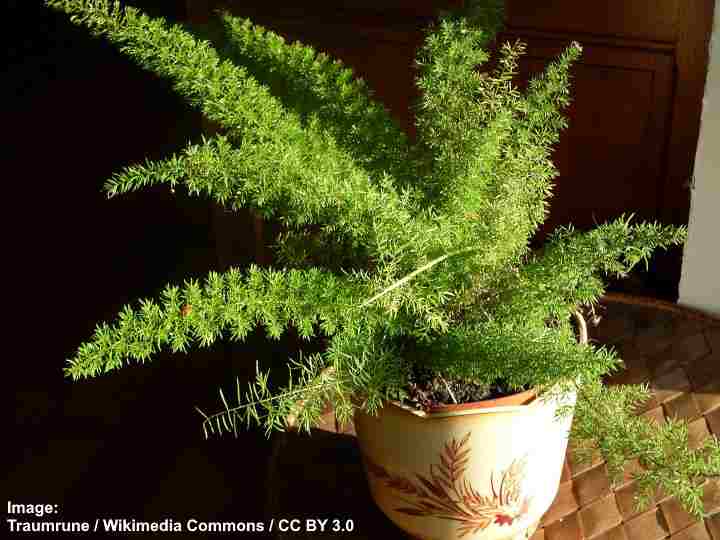Foxtail Fern: Caring for Asparagus Foxtail Fern (Asparagus Meyeri)

Foxtail ferns are ornamental evergreen plants with plumes of bushy green foliage. Asparagus foxtail ferns are perennials in the family Asparagaceae and are not a true fern. Foxtails ferns get their name from their fern-like leaves that grow in conical, bottlebrush shapes—just like a fox’s tail. Foxtail ferns grow outdoors in USDA zones 9 to 11.
Asparagus ferns are a group of leafy, herbaceous plants that are related to the vegetable asparagus. Most varieties of asparagus ferns are small flowering shrubs with lush light-green foliage. The fern-like plants are known for their feathery clumps of leaves.
Asparagus Foxtail Fern (Asparagus densiflorus ‘Myersi’) Facts

When grown outdoors, asparagus foxtail fern can become invasive unless it is grown in containers
Foxtail ferns are a plant species with the botanical name Asparagus densiflorus ‘Myersi.’ However, other botanical names include Asparagus densiflorus Myersii,’ Asparagus densiflorus ‘Meyeri,’ and Protasparagus densiflorus ‘Myersii.’
The common name ‘foxtail fern’ comes from its bushy plumes growing in a cylindrical or conical shape. The long spear-like fronds or leaves rise and twist, giving the emerald-green plant high ornamental value. The plush, soft, evergreen foliage grows in clumps to give the ferny plant a spiky appearance.
Foxtail ferns grow up to 2 ft. (0.6 m) and 4 ft. (1.2) wide.
Foxtail ferns are called ‘ferns’ because of their feathery foliage. Unlike real ferns in the class Polypodiopsida, foxtail ferns reproduce by producing seeds, not spores.
Foxtail fern leaves—botanically speaking—are not real leaves, but a type of cladode. A cladode is a type of leaf-like structure on plants and is required for photosynthesis. For simplicity, we will refer to foxtail fern cladodes as leaves in this article.
Foxtail fern (Asparagus densiflorus ‘Myeri’) produces clusters of inconspicuous fragrant, white flowers. The tiny flowers bloom in spring and summer. After flowering, red berries appear on the tiny thorny stems.
Foxtail asparagus is a plant with vigorous growth, especially in warm, tropical climates. Generally, grown as an outdoor plant, it’s vital to remember that the fast-growing plant can become invasive. Its bulb-like, tuberous roots spread quickly unless it is grown in containers.
How to Care for Asparagus Foxtail Ferns — Overview
Grow foxtail ferns in organically rich, consistently moist, and well-draining soil. Foxtail ferns thrive in partial shade or bright indirect light. Water foxtail ferns when the soil partially dries and grow in temperatures between 65°F and 75°F (18°C – 24°C). Frost will cause foxtail ferns to die back, but the roots remain hardy to 24°F (-4°C).
Other Types of Asparagus Ferns
Here’s a brief overview of other species of asparagus ferns.
Asparagus Plumosa Fern (Asparagus Plumosus)

Asparagus Plumosa fern (Asparagus plumosus) also has the botanical names Asparagus setaceus and Protasparagus setaceus
Asparagus plumosa ferns have triangular, flattened sprays that resemble typical fern fronds. The leaf stems have clusters of tiny green pine-like needles and grow up to 2 ft. (0.6 m) tall. Plumosa ferns produce clusters of small white flowers, followed by red berries.
Sprenger Asparagus or Sprengeri Fern (Asparagus densiflorus ‘Sprengeri’)

Sprenger asparagus fern
Sprenger ferns have long, arching fern-like sprays that grow up to 3 ft. (1 m) tall. The emerald-green feathery foliage is made up of soft needles. Sprenger’s asparagus is also called the asparagus emerald fern.
Compact Sprenger Asparagus Fern (Asparagus densiflorus ‘Sprengeri Compacta’)
This asparagus cultivar ‘Sprengeri Compacta’ fern has compact growth and reaches 2 ft. (0.6m) high. Like the Sprengeri fern, this plant has delicate, fern-like leaves. This asparagus fern is ideal for growing indoors in hanging baskets.
Ming Fern (Asparagus retrofractus)

There are many botanical names for ming fern (Asparagus retrofractus), including asparagus macowanii, asparagus myriocladus, and asparagus macowanii ‘Myriocladus.’
Also called Chinese Ming ferns, Asparagus retrofractus has long, thin woody stems with clusters of needle-like cladodes. Ming ferns are also called pom-pom asparagus ferns or zig-zag ferns.
Asparagus Foxtail Fern Care
Asparagus densiflorus ‘Myers’ ferns are easy-to-care-for plants. Generally, foxtail ferns grow outdoors in warm climates and sunny locations that are protected from direct midday sunlight. You can also grow foxtail ferns in containers indoors.
Here is how to care for asparagus foxtail fern.
Asparagus Foxtail Ferns Light Requirements
Foxtail ferns thrive in bright, indirect light. The best location for growing foxtail ferns in your backyard is where they get morning sun but are in the shade from midday onward. Too much sunlight can cause the delicate needle leaves to burn and start to yellow. However, too little light, and the emerald plumes may also turn yellow.
Asparagus foxtail ferns need protection from direct sunlight when growing as a houseplant. Place the potted ‘fern’ in a bright spot but away from direct sunlight. If necessary, place the foxtail fern pot behind a sheer curtain or at least 2 ft. (0.6 m) away from a sunny window.
Although foxtail ferns will grow in the shade, they are not on the list of houseplants that don’t need sunlight. So, whether grown indoors or outside in your yard, ensure the foxtail fern plant gets plenty of bright indirect light.
The Best Type of Soil for Growing Asparagus Foxtail Ferns

To care properly for your foxtail fern indoor, make sure to grow it in fertile well-draining soil
Foxtail ferns need well-draining fertile soil for best growth. Generally, asparagus foxtail plants aren’t fussy about the type of ground they grow in. The most critical care factor is that the tuberous roots don’t stand in soggy, overly-damp soil. Foxtail ferns are relatively resistant to drought once established.
The potting mix for asparagus foxtail ferns should be light and aerated to allow water to drain freely. A combination of peat moss and perlite for drainage creates an ideal growing medium for growing in containers. Peat moss is slightly acidic and retains some moisture—ideal for foxtail ferns. Perlite or coarse sand ensures that plenty of oxygen circulates in the potting mix.
Please check out the article on the best DIY potting soil recipes for houseplants to find out more about growing potted plants indoors.
How to Water Asparagus Foxtail Ferns
Foxtail ferns require regular watering to prevent the soil from drying out. Water foxtail ferns whenever the top 2” to 3” (5 – 7.5 cm) of soil is dry. You may need to water foxtail ferns outdoors once a week in summer if it hasn’t rained.
The taproot (tuber) of foxtail fern stores water—so, water the plant in the same way you water and care for succulents.
Indoor foxtail ferns require watering as often as the potting mix partially dries. In summer, you may have to water weekly, but in winter—less often. However, before watering your foxtail fern houseplant, check the soil for dryness. Ideally, the soil around the bulbous root should be moist, never soggy.
When watering foxtail ferns, always thoroughly drench the soil. This type of deep watering ensures the roots get enough moisture. But you must let the soil partially dry out between waterings. Otherwise, you risk causing root rot, which will eventually kill the plant.
Water foxtail ferns in pots by pouring in enough water until it drains out the bottom. Allow all the excess water to drip out before placing the pot back on its tray. Put the plant pot back in a bright place, protected from direct sunlight.
Related reading: The best care tips for watering houseplants.
Asparagus Foxtail Ferns Temperature Requirements

Foxtail ferns grow best in warm temperatures and can be grown outdoors in USDA zones 9-11
Foxtail ferns thrive in warm climates. The ideal temperature for growing asparagus foxtail plants outside is between 65°F and 75°F (18°C – 24°C). Foxtail ferns won’t tolerate temperatures lower than 24°F (-4°C). However, if temperatures drop to below 50°F (10°C), growth will slow down, and you risk plant damage.
If you live in USDA zones 9 to 11, you can grow foxtail ferns in your backyard all year long. In colder climates, foxtail ferns grow outside in containers on patios, deck areas, or balconies in summer. When average temperatures drop to around 50°F (10°C), you should bring the plant indoors.
Asparagus Foxtail Ferns Humidity Requirements
Foxtail ferns have medium to high humidity needs. Humidity isn’t usually a problem when growing outdoors in semi-tropical or tropical climates. However, foxtail ferns need extra humidity when growing indoors. Average household air moisture levels are generally too low for healthy tropical plant growth.
Mist foxtail ferns regularly to increase humidity levels. It’s best to use distilled or filtered water to prevent damaging the delicate needle-like leaves. Set the spray to the finest setting and mist over the fern’s crown. Spray the foxtail fern daily to ensure it gets enough humidity.
Other ways to humidify foxtail ferns include setting the pots on a tray containing pebbles and some water, using a room humidifier, or grouping your tropical houseplants together.
Fertilizing Asparagus Foxtail Ferns

You can fertilize foxtail asparagus fern during the growing season from spring until summer
Foxtail fern benefits from regular fertilizing during the growing season—from spring until summer. In the backyard, adding compost to the garden and mulching around the plants encourage healthy growth. The compost adds nutrients to the ground, and mulch prevents moisture from evaporating.
If growing foxtail ferns in containers—whether indoors or outdoors—regular fertilization can ‘feed’ the plant. Apply a half-strength water-soluble fertilizer once a month. Or, you can use a slow-release fertilizer three times during the growing season—in spring, summer, and fall.
The best types of houseplants fertilizers are natural, organic ones. Natural ingredients such as seaweed, liquid kelp, worm castings, fish emulsion, plant extracts, or compost tea provide minerals and nutrients. These fertilizers benefit foxtail ferns as they don’t cause a buildup of mineral salt in the potting mix.
How to Prune Asparagus Foxtail Ferns
Pruning foxtail ferns is rarely necessary, especially if you’re growing the fast-growing plants as ground cover. Due to its dense growth, trimming old or dying stems encourages new stems to grow. Trimming off brown or dying branches allows the plant to give energy to new growth. Also, removing dead branches improves the plant’s aesthetic appeal.
Prune foxtail ferns by trimming back old woody stems near their base. Using sterilized pruning shears, remove all unsightly foliage from the plant. Foxtail ferns have vigorous growth and will withstand heavy pruning.
You may need to wear protective gloves to protect your hands from the stem spines, but the thorns are very small and are usually not a problem.
The best time to prune plants, including species of Asparagus densiflorus, is in spring or early summer. However, with foxtail ferns, you can lightly prune them at any time of the year.
Repotting Asparagus Foxtail Ferns
Foxtail ferns may need repotting every spring. Transferring the vigorous evergreen plant to a large pot allows more room for the roots to grow. Also, repotting asparagus ferns lets you refresh the potting mix and check for signs of disease. When repotting the plant, you can also divide the taproot to propagate new plants.
Here are steps for repotting asparagus foxtail ferns:
Choose a pot that is 1” or 2” (2.5 – 5 cm) larger than its current one. Don’t choose a pot too large as that can result in excess soil moisture and diseased roots. You should also choose a pot with drainage holes.
Carefully remove the foxtail fern from its current container. You may need to wear protective gloves to prevent the spines from jagging your hands. Shake all the excess dirt free from the roots.
Half-fill a new pot with an appropriate potting mix for asparagus ferns. Place the tuber in the pot and fill the remainder of the container with the potting soil. Gently press down the soil to give the plant some support.
Give the foxtail fern a thorough watering and then place it in a bright location with indirect sunlight.
How to Propagate Asparagus Foxtail Ferns
Root division is the best way to propagate foxtail ferns. Propagating asparagus ferns by dividing the roots is simple and straightforward.
Here is how to propagate foxtail fern:
Ease the foxtail fern from its container. Gently remove any loose soil on the roots. Lay the plant on its side. Using a sterile knife, cut the tuber root into two or three sections (depending on the root size). Repot the root sections in individual containers using an appropriate potting mix.
It’s easy to propagate asparagus foxtail ferns growing in the garden. While the plant is still in the ground, use a spade to slice through the plant’s center. Gently ease the section of the plant you want to replant. Choose a partially shaded area of your backyard to plant your new foxtail fern.
Are Asparagus Foxtail Ferns Toxic?
Foxtail ferns contain toxins that are poisonous for cats and dogs. According to the American Society for the Prevention of Cruelty to Animals (ASPCA), repeated exposure to Asparagus densiflorus foliage can cause dermatitis. Dogs or cats that ingest the berries can develop abdominal pain, diarrhea, or vomiting.
Pests that Affect Asparagus Foxtail Fern Growth
Foxtail ferns are relatively resistant to pests. The most common type of bugs to affect asparagus foxtail ferns are mealybugs or scale insects. Mealybugs look like tiny white creatures that leave behind a white fuzzy substance. Scale insects are difficult to spot, but they may look like bumpy growth on the woody stems.
Mealybugs and scale insects weaken plant growth by sucking juices from the stems. So, it’s vital to treat plant pests as soon as possible.
To get rid of bugs from foxtail ferns, use a neem oil solution. Fill a spray bottle with lukewarm water and add 1-2 tsp. organic neem oil and 1 tsp. mild dish soap. Shake well. Spray the neem oil pesticide liberally on the foxtail fern’s foliage and allow it to dry. Repeat the process once a week to get rid of mealybugs or scale.
For asparagus foxtail ferns growing in your yard, you can turn a high-pressure hose on them to dislodge any pests lurking in the dense foliage.
Diseases that Affect Asparagus Foxtail Fern Growth
Root rot is the most common disease that affects foxtail ferns. As foxtail’s thick roots store moisture, overwatering foxtail ferns causes fungal or bacterial diseases to thrive, and that can cause the root to decay. Signs of root rot are wilting growth and yellow leaves. The best way to prevent root disease is to water the plant only when the soil is partially dry.
If you suspect that root rot is affecting a foxtail fern, you’ll need to remove the plant from its container. Inspect the tuber root for signs of decay and cut off any mushy parts. You’ll need to hold off watering until the plant recovers, and the soil has mostly dried.
FAQs About Asparagus Foxtail Fern Care
Foxtail ferns are easy-care plants for your backyard or indoors. But there are a few care issues that can indicate problems with plant growth.
Why are foxtail fern leaves yellow?
There are three reasons why asparagus foxtail leaves turn yellow—too much direct sunlight, overwatering, or lack of light.
Overwatering is the leading cause of asparagus fern leaves turning yellow. Too much soil moisture drowns the roots, preventing them from absorbing enough nutrients.
Too many hours of direct sunlight and hot conditions scorch the delicate needle-leaves. This can cause the lush emerald green leaves to become yellow and discolored.
Foxtail ferns—unlike real ferns—can’t survive in dark conditions. So, you may need to move the bushy fern plant to a brighter room or move it out of continual shade.
Why are foxtail fern leaves turning brown?
Age can cause asparagus foxtail ferns leaves to turn brown. This is just part of the growth process and is nothing to worry about. You can remove the brown, unsightly stems to allow fresh, new green sprays to grow in their place.
If many asparagus fern leaves are turning brown at the same time, it could be a sign that conditions are too hot. Scorching temperatures over 90°F (32°C) can burn the leaves. In hot, arid conditions, you need to provide shade for the asparagus ferns and plenty of water.
Read about other types of asparagus ferns to grow outside and indoors (with pictures).
Related articles:
